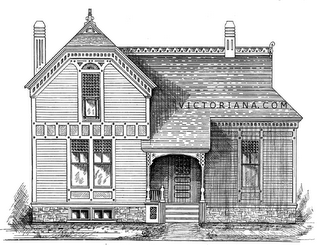Family Stucture in Victorian Architecture

The structure of a house is representative of the structure of the family within it. If you were to look at the history of American houses you would see vast changes in the way we live. Many of these changes can be associated to changes in how we build houses, but the actual layout of a house is representative of the social values of that time period. The Victorian age in the late 1800’s brought about a change to the home. The architecture of the classic Victorian home reveals a formally structured family hierarchy, maintained and upheld by the use of public and private space in the home.
The Hierarchy of House and Home
The layout of the Victorian home is not only important in its use of public and private space but also in its creation of a hierarchy. There was a desire in the late 1800s to determine and maintain a place for everything, as George Augustus Sala, a journalist in the Victorian era, put it “subdivision, classification, and elaboration are certainly distinguishing characteristics of the present area of civilisation (Flanders, p. 10).” What this means for the home is that everything and everyone had a place, and this is visible in the structure. In comparison to older housing styles where rooms were multifunctional and most of the space was communal, in the Victorian home there is a rigid separation of every room.
Upon entering a Victorian house you would step into a hallway where you could immediately find the parlor, a place for the public, and near there you would find the dining room. The kitchen was most often placed in the rear of the house but no matter where it was, it was not attached to any of the common spaces such as the parlor or dining room. Since there was no desire for there to be common sleeping areas, you would find any number of small individual bedrooms in the house; this often required most houses to have a second floor. Essentially the Victorian style changed the structure of the house, altering the hallway, kitchen, and parlor most specifically.

The layout of the Victorian house was designed with a clear intention of creating a hierarchy. Those areas that were considered public areas were always considered the most important, while areas that were private were of lesser importance. It was also important those areas remain separate from the private areas. One place this can be seen is the necessity of a parlor over a bedroom. Just about everybody, no matter their station, had a parlor, even in some of the lower income homes were people would sleep in the parlor, often the beds would be moved out of the room during the day (Schlereth p. 120). As for the bedrooms, those created another kind of hierarchy. Not only did the parents’ room become separate from the children’s room but there was a desire to separate the children. First it was important that the boys and girls were separated, then, if possible, the older children should be separated from the younger.
The way the Victorian house was arranged was in response the views and beliefs of that era. In a time of biological classification and social Darwinism, people were trying to find absolute truths about the world around them. Science was the answer to our problems, that if we incorporated scientific ideas and principals into our everyday lives, things would improve. This can be seen in many aspects of society in the late 1800’s, but its appearance in the structure of the house tells us just how much the family was affected by these changes.
Public v. Private Space
One of the most distinctive aspects of the Victorian home, as mentioned earlier, is the fact that it was one of the earliest styles of home architeture that gave the family members separate spaces from each other and from the public. The hall and the parlor, in particular, were very public parts of the home and were kept very separate from private living spaces.
The floor plans of a traditional Victorian house suggest that when a guest entered the house, they would be met visually with only the hall and the stairs. All other parts of the home were off to the sides or upstairs, behind closed doors. If a guest was lucky, they would be invited from the hall into the parlor, but never would they see the bedrooms or the kitchen. For this reason, most families kept the finest of their belongings in the hall and the parlor, along with photographs and needlework that they thought best represented the home’s inhabitants to the outside world. In fact, urban parlors tended to be a tribute to the spending habits of the people (Schlereth p. 123). In other words, a large part of their purpose was to impress guests.

Such a blatantly public space implies that there must have been an equally limited private side to a Victorian household. Again, everything and everyone had its place, and the rigid structure of the home made sure that each member of the family was confined to his or her private area, unless formally presentable to the public. There was no sense of family intimacy beyond the parlor space, which was still very formal. This means that any individual chore or responsibility could not have been shared among the family members. Each individual’s personal burden remained private and separate, just like the rooms of the house. In this way, the strict family hierarchy was maintained. Limited sharing of responsibility meant limited mobility in “family rank.”
It would be very difficult to tell for sure whether the the rigitidy of the Victorian era family influenced the construction of their homes or whether the home architeture nurtured a certain type of family relationship. Either way, the Victorian style house gives us a tangible look at family living in the 1890s (as well as the rest of the era). Like life itself at the time, Victorian houses are formal and orderly, displaying their assets proudly while shielding their inner workings from the world. It was this cooperation between public and private that allowed such a decorous and structured lifestyle to function.
Bibliography
Carley, Rachel. The Visual Dictionary of American Domestic Architecture. Henry Holt & Company; New York, NY. 1994
Flanders, Judith. Inside the Victorian Home. W.W. Norton & Company; New York, NY. 2004
Schlereth, Thomas J. Victorian America: Transformations in Everyday Life. HarperPerennial; New York, NY. 1992
“Victoriana” Online. Accessed April 30, 2006.
